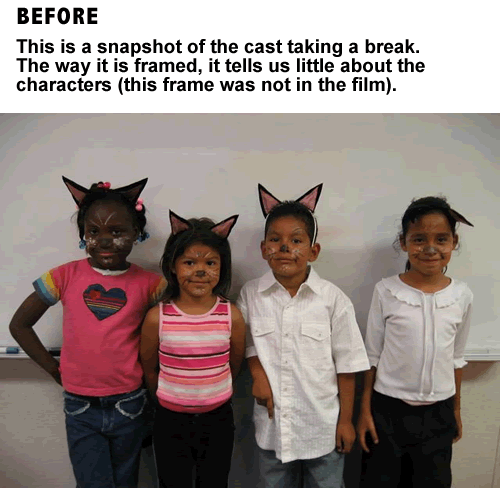An interesting conversation began in Students 2.0, where Anthony, a high school student, wrote,
“…like home movies, most…student videos are lacking a thesis and a design to support them. As technology allows us to integrate creative projects…we need to give students the tools to funnel their creative efforts into an effective and cohesive whole.”
I made the point that teachers need to be showing students basic elements of film language if they’re going to ask students to make films. We would never teach writing without teaching students how to read text. How can we teach film without pointing out how to read film language?
Anthony felt that this was out of reach of most teachers. He’s probably right since most teachers don’t have this knowledge themselves. However, I don’t think it’s hard for a teacher with an ounce of motivation to learn how to analyze film nor does it take a lot of time to teach because most of us are already subconsciously aware of what goes into the “design” of films.
Tom of Bionic Teaching picked up on this thread and posted an excellent Before and After Powerpoint example of how a powerpoint slide could be improved through better storytelling and by linking design to the storytelling of the slide.
I’d like to try to illustrate the point from a film making perspective and demonstrate how this relates to film. Specifically, let’s look at framing from high and low angles and at varying distances.
These shots come from our film “The City Mouse and the Country Mouse” which was made almost entirely with still images in my first grade class. In this scene, a mouse party is interrupted by the entrance of a cat in the room. The mice flee and a chase ensues.

Most of the teacher and student films I see look worse than the above shot in that they’re taken from even farther away and the camera never moves from that position. The cat might enter, turn her back to the camera and the mice would quickly run off-frame.



So we looked at at least three things in this brief example:
Shooting from different angles can make characters more or less powerful.We can show character’s point of view by cutting to what they are looking at.Shooting from different distances conveys different information about a scene.
Naturally there are technical names for these shots and techniques but I’m trying to simplify things so that a teacher who knows nothing else could teach this.If teachers would teach just these basic film elements by analyzing any popular media, students would be able to produce better video and be better able to analyze all types of media.
Related:
Reflection on AFI’s Screen Education Series
Oh that’s very good, Mathew! Your examples with the shots in City Mouse, Country Mouse really help to illustrate film making principles without getting technical. Just what a lot of people need. I’ll save that. (and yes I’m putting off my wood-hauling)
Great points! I have a ton of awesome writing teachers on our staff, yet they do not feel they have the skills to do techy things like make movies or do blogs. As you said, if they just pay attention to the media they enjoy and monitor a few of the skills and tricks used in its making, they would be much more in tune with video. I will be passing this post along to them as well as my new Final Cut Studio teacher. Thanks for pointing me back to your post!
These are some great examples, and they’re really inspiring to teachers who may feel intimidated by making something like this on their own. It really isn’t that hard when it all comes down to it, and the kids really benefit!
Mathew,
I’d like to use digital story telling in my grade nine locally developed math class this semester to tell the story of measurement, decimals. fractions etc. I’ve read your film techniques and they certainly helped me understand what I need to do.
My math students are relucatant learners needing lots of support. I am hoping that digital story telling will catch their imagination and help them understand math better.
Thanks.
Wait. A high school student said that?
@therapydoc Yes, a high school student. Students 2.0 is a group blog written by a group of them.
Tales from the Yard had great examples and will “turn on” our teachers to movie making.